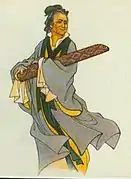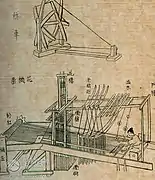Huang Daopo
Huang Daopo (simplified Chinese: 黄道婆; traditional Chinese: 黃道婆; pinyin: Huáng Dàopó; c. 1245 – 1330) rose from poverty to become one of the most famous women in the early Chinese textile industry.
Biography
Huang was likely born around 1240 or 1245. Her family name was Huang, and Daopo was an honorific that she was given later in life. Coming from a poverty stricken family, Huang ran away from home when she was ten years old after being sold into marriage by her family. Unable to bear the constant ill-treatment she received, Huang followed the Huangpu River from her home in Songjiang, near Shanghai then boarded a ship bound for the port of Yazhou in Hainan. In Yazhou she learnt spinning and weaving from the local Li people.[1]
Around 1295, Huang returned to Songjiang and began to teach the local women about cotton spinning and weaving technology whilst at the same time manufacturing suits, fine silk fabrics and weaving machinery (such as fluffing machines, crushers and three-spindle treadle powered weaving looms) that greatly increased efficiency. From the weaving aspect, Huang produced mixed cotton fabrics, colored fabrics and fabrics with mixed warp and weft fibers. Her weaving technology made her hometown famous and began its textile manufacturing industry.[1]
Shanghai Botanical Garden hosts the Huang Daopo Memorial Hall in her honor.[2] The TV series A Weaver on the Horizon is a fictionalized version of her life.[3] A crater on Venus is named for her.[4] In 1980, she was featured on a Scientists of Ancient China stamp.[5]
 Drawing of Huang
Drawing of Huang Diagram of Huang's weaving machine
Diagram of Huang's weaving machine Tomb of Huang Daopo
Tomb of Huang Daopo
References
- Maggs, Sam (2016). Wonder Women: 25 Innovators, Inventors, and Trailblazers Who Changed History. Quirk Books. pp. 131–134. ISBN 9781594749254.
- "Geranium the star at city flower show". english.china.com. Retrieved 2020-07-28.
- "《天涯织女》创收视新高 郑国霖获女性观众青睐". Tencent. Archived from the original on 2017-10-09. Retrieved 2017-07-10.
- "Venus Crater Database, Huang Daopo". www.lpi.usra.edu. Retrieved 2020-07-28.
- "The Representation of Science and Scientists on Postage Stamps". press-files.anu.edu.au. Retrieved 2020-07-28.